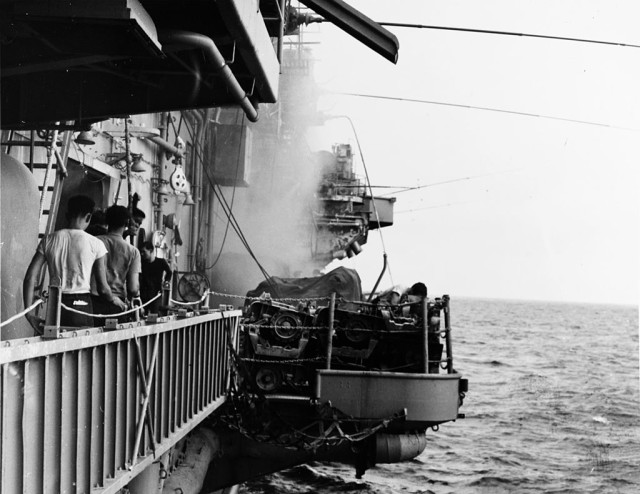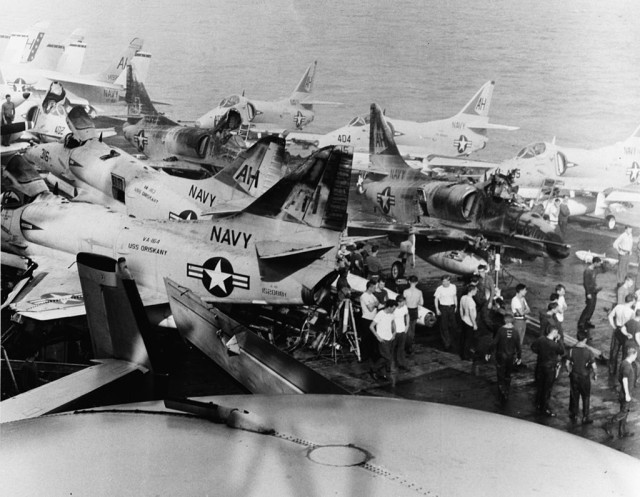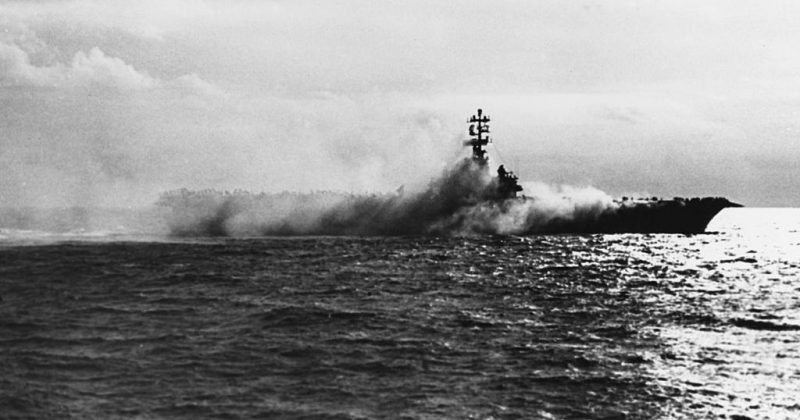On the morning of the 26th of October, 1966 the USS Oriskany was stationed 50 miles off the north coast of Vietnam. A group of Skyhawk jet bombers was being prepared for action in the hanger below.
Oriskany, an Essex Class Aircraft Carrier, had seen plenty of action during the Vietnam War. However, that morning would see the heaviest losses – without an enemy ship in sight.
At around 0730 the ship’s fire alarm sounded. A parachute flare had accidentally ignited in the forward flare locker of one of the hangers below the flight deck. The sailor who had been handling the magnesium flare panicked and instead of throwing it overboard, he made the worse possible mistake. He threw the burning flare back into the locker where hundreds of other flares were stored – causing them to explode in a matter of minutes.
The alarm was raised with the klaxon sounding across the ship and the loudspeakers announcing that this was definitely not a drill. The fire which had started on the starboard side of the ship’s forward hangar bay soon spread throughout the ship’s decks. Because the ship was getting ready to launch aircraft, it was situated forward to the wind, which drew the heat and smoke towards the berthing quarters.
The well-trained fire crew, assisted by all crew members who were not already trapped by the fire, quickly moved into action. Two different tactics were needed to get the fire under control. As well as attempting to put the blaze out they had to remove anything which might feed the fire and cause further explosions.
Three planes laden with bombs as well as a fully loaded fuel tanker had to be rolled to the other side of the ship. Meanwhile, the heat was building up in the flare locker till at last the steel hatch exploded throwing out fireballs which ignited two helicopters, killing five sailors. Ordnance experts had the task of throwing bombs weighing up to 2,000lb overboard to prevent further explosions.
While this was going on the fire crew tackled the blaze with hoses aided by the ship’s sprinkler system. Although this helped to put out the flames, it also created a mass of thick grey smoke which hindered another very important part of the operation – the attempt to rescue those trapped by the blaze

Trapped Below Deck
When the fire broke out hundreds of the Oriskany’s 3,400-man crew were still below deck. These were mostly pilots who occupied the staterooms of the “Officer’s Country” some of whom had still been in their bunks when the alarm sounded. As they tried to escape they were driven back by the smoke and heat in the passageways. Once the crew on deck became aware of their situation they used the portholes to pass down fire-fighting equipment to some of those trapped below.
Sailors tried to protect themselves by wrapping themselves in wet blankets while they attempted to get back on deck where at least they had some chance of getting to safety. One trapped pilot managed to escape by tearing out the air conditioning and removing his clothes so that he could squeeze through the narrow shaft to reach the marginally safer deck above. Once on deck he was given a firefighting suit and joined in the effort to put out the blaze which was still spreading dangerously fast.
A fireman in the pump-room elevator made what could have been a fatal mistake by opening the hatch unaware of the huge amount of water from hoses and the sprinkler above the hatch. Before he realised the situation, the water poured into the hatch and he was eventually saved from drowning when one of the men was able to pass scuba gear down to him which allowed him to get out of the elevator safely. A call went out for medical assistance and was answered by two of the Oriskany’s sister ships, Constellation and Franklin D Roosevelt.
At around 1030 that morning, after three hours of intense efforts by members of the crew, the fire was at last under control. There were still a few smaller isolated fires to be dealt with and it took another five hours till the fire marshal could declare that the blaze had been extinguished completely. Oriskany could not remain on station, so it soon began its journey across the South China Sea to the Subic Bay Naval Station in the Philippines.

The Aftermath
Forty-three men died in the blaze and one more died of his injuries in the days after the fire. Many of those who died were veteran combat pilots who had survived dangerous raids not long before. More lives were lost that single morning than in the rest of the Oriskany’s entire war service.
An investigation into the cause of the blaze decided that it was due to a combination of poor design and human error. The investigation revealed that a very small proportion of this type of flare could be ignited accidentally if the flare was jarred. Also, the actions of the sailor who had responded so disastrously had clearly been a huge factor in turning a small accident in a major tragedy. Although several sailors were at first court-martialed over the disaster the charges against them were dropped later.
Several changes were made in the aftermath of the blaze on the Oriskany to ensure that the same thing would not happen again. The Navy changed the design of the flare they used to remove the risk of accidental ignition and crew numbers were also increased to ensure that there was enough staff to ensure that all activities were properly supervised.
There were many acts of heroism that day which was recognised by the naval authorities. Particular mention was made of the contribution of the youngest recruits; teenagers who had just been drafted in had thrown themselves into the rescue effort with commitment and bravery which had impressed their older more experienced colleagues.
The response of the crew was highly praised, and the authorities recognised that it was only because of their dedication and bravery that there were not more fatalities.
